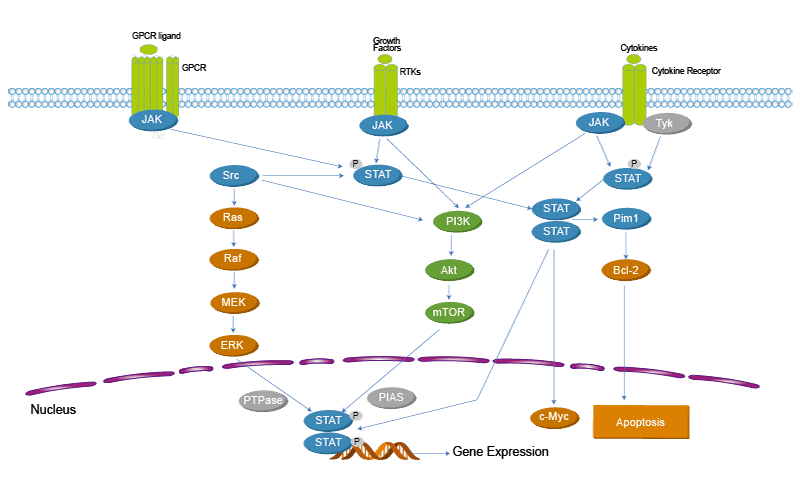JAK/STAT signaling pathway inhibitors
Inhibitors on JAK/STAT signaling pathway from MedChem Express are available at Bio-Connect Life Sciences
The Janus kinase (JAK)/signal transducer and activator of transcription (STAT) pathway is central to signaling by cytokine receptors, a superfamily of more than 30 transmembrane proteins that recognize specific cytokines, and is critical in blood formation and immune response. Canonical JAK/STAT signaling begins with the association of cytokines and their corresponding transmembrane receptors. Activated JAKs then phosphorylate latent STAT monomers, leading to dimerization, nuclear translocation, and DNA binding. In mammals, there are four JAKs (JAK1, JAK2, JAK3, TYK2) and seven STATs (STAT1, STAT2, STAT3, STAT4, STAT5a, STAT5b, STAT6).
JAKs are an integral component of the receptor subunit with very little release or exchange into the cytoplasm and as such are located primarily at the plasma membrane. STAT has seven conserved features: an N-terminal domain (NT), a coiled-coil domain (CC), a central DNA-binding domain (DBD), a linker region, an SH2 domain followed by a single conserved tyrosine residue, and a C-terminal transactivation domain (TAD). JAK phosphorylation of the STAT proteins then results in a spatial reorganisation of the dimer complex, and translocates to the nucleus. Once in the nucleus, STAT dimmers are stabilised by NT:NT interactions and bind cooperatively to tandem sequence elements within promoter regions to activate the transcription of specific gene subsets.
Aberrant activation of the JAK/STAT pathway has been reported in a variety of diseases, including inflammatory conditions, hematologic malignancies, and solid tumors. More recently, human myeloproliferative neoplasms are discovered to be associated with a unique acquired somatic mutation in JAK2 (JAK2 V617F), rare exon 12 JAK2 mutations, or thrombopoietin receptor mutations that constitutively activate wild-type JAK2. As a result, several drug companies have begun to develop therapeutics that inhibit the function of JAK tyrosine kinases. Currently, several JAK-targeting drugs have been used in the clinic for treating diseases including rheumatoid arthritis and myeloproliferative.
JAK/STAT signaling pathway

JAK/STAT products
References
- Kiu H, Nicholson SE. Biology and significance of the JAK/STAT signalling pathways. Growth Factors. 2012;30(2):88-106.
- Quintás-Cardama A, Verstovsek S. Molecular pathways: Jak/STAT pathway: mutations, inhibitors, and resistance. Clin Cancer Res. 2013;19(8):1933-1940.
- Villarino AV, Kanno Y, Ferdinand JR, O’Shea JJ. Mechanisms of Jak/STAT signaling in immunity and disease. J Immunol. 2015;194(1):21-27.
- Vainchenker W, Constantinescu SN. JAK/STAT signaling in hematological malignancies. Oncogene. 2013;32(21):2601-2613.

 Find products for your research
Find products for your research